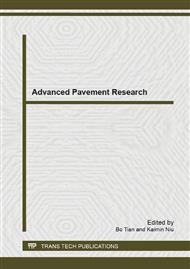p.166
p.173
p.183
p.190
p.200
p.204
p.212
p.222
p.227
Influences on the Axle Load Stress of the Cement-Concrete Pavement Structure Caused by the Crack or Cutting Crack of the Semi-Rigid Base
Abstract:
Some horizontal cracks will appear during the strength formation of the semi-rigid base, for the influences of dry shrinkage and temperature shrinkage exist, so the engineers often adopt the manual method of equidistant cutting crack to avoid the irregular cracks. In order to analyse the influences on the axle load stress of the cement-concrete pavement slab which caused by the width and position of the base cracks or cutting cracks, the 3D FEM was used to study them under the different working conditions considering the crack, width and position. By the above research, the results show the existing cracks affect the integrity and continuity of the pavement structure; The crack width has no large influence on the stress of the pavement slab, while the base stress decreases apparently with the increasing width, and it becomes stable finally; The stress of the pavement slab is maximum when the crack or cutting crack is located in the middle, while it's small when the crack or cutting crack is located in the one fourth of the pavement slab.
Info:
Periodical:
Pages:
200-203
Citation:
Online since:
December 2013
Authors:
Price:
Сopyright:
© 2014 Trans Tech Publications Ltd. All Rights Reserved
Share:
Citation:


